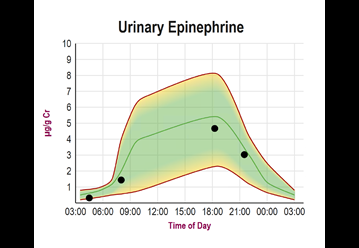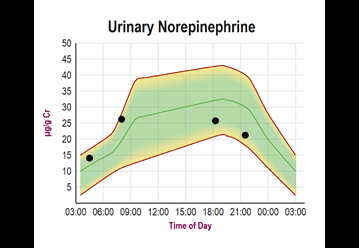Diurnal Curves for Chronic Stress
Much like the Cortisol Awakening Response (CAR) is a helpful tool for looking at the body's awakening stress response, severe fatigue may be more completely assessed with the aid of diurnal epinephrine and norepinephrine patterns.
Both excitatory neurotransmitters, epinephrine and norepinephrine regulate the “fight or flight” response, elevate blood pressure and heart rate, stimulate wakefulness and reduce digestive activity.
Under conditions of little to no stress, early morning norepinephrine and epinephrine levels are low, increase towards mid-morning, peak in the afternoon, and decrease by bedtime with low levels during the night.
Under conditions of acute stress, the sympathetic nervous system signals to release epinephrine and norepinephrine, contributing to higher blood pressure, increased breathing rate, mobilization of glucose from storage, increased heart rate and increased muscle strength.
Diurnal curves of epinephrine and norepinephrine can easily be assessed by taking four daily dried urine collections – typically done upon waking, two hours after waking, before dinner and before bed – and charting them on a 24-hour graph.
The added benefit to ZRT’s dried urine testing is that epinephrine and norepinephrine can be measured in combination with cortisol and melatonin, so those who want a complete adrenal assessment can now get all of these together in the Sleep Balance profile.


Several ZRT dried urine profiles include the diurnal epinephrine and norepinephrine curves. Just look for the Epi x 4 and NE x 4 indications in the profile. Download a complete list of profiles below.
Blog: Diurnal Fluctuations in Norepinephrine & Epinephrine as Part of the Healthy Stress Response
Download: ZRT Overview of Profiles

